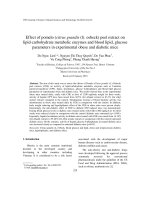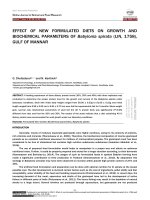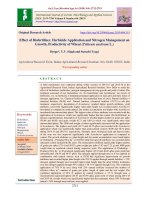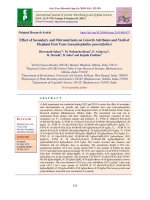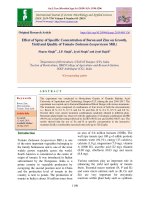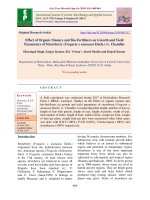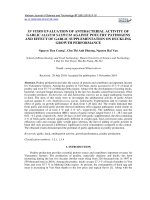Effect of sulphur and boron on growth and yield of sunflower (Helianthus annuus L.)
Bạn đang xem bản rút gọn của tài liệu. Xem và tải ngay bản đầy đủ của tài liệu tại đây (141.36 KB, 4 trang )
Int.J.Curr.Microbiol.App.Sci (2020) 9(8): 3320-3323
International Journal of Current Microbiology and Applied Sciences
ISSN: 2319-7706 Volume 9 Number 8 (2020)
Journal homepage:
Original Research Article
/>
Effect of Sulphur and Boron on Growth and Yield of
Sunflower (Helianthus annuus L.)
Thakur Indu and Rajesh Singh*
Department of Agronomy, Sam Higginbottom University of Agriculture, Technology and
Sciences, Prayagraj, India
*Corresponding author
ABSTRACT
Keywords
Sunflower, Kharif,
Sulphur, Boron,
Growth, Yield
attributes, Oil
content
Article Info
Accepted:
26 July 2020
Available Online:
10 August 2020
A field Experiment was conducted during kharif 2019 at Crop Research
Farm, Department of Agronomy, SHUATS, Prayagraj (U.P.). The
experiment was laid out in Randomized Block Design, comprising of two
factors and 9 treatments, each replicated thrice viz., Sulphur (30 kg/ha & 50
kg/ha) and two application methods of Boron as soil application (1 kg/ha)
and as foliar application (0.2% boron spray) at ray floret stage and the
effect was observed on growth and yield of sunflower. Application of
Sulphur and Boron significantly influenced the growth parameters, Yield
attributing characters, Yield and Oil content over control. Addition of (50
kg/ha Sulphur + 1 kg/ha Boron recorded highest Plant height (145.69 cm),
Number of leaves per plant (23.20) Maximum stem girth (3.06 cm) at 60
DAS, whereas, maximum values of Capitulum diameter (15.5 cm), Seed
yield (1476.71 kg/ha), Oil content (45.70 %) were recorded with
application of (50 kg/ha Sulphur + 0.2% spray Boron) in Sunflower.
Introduction
Sunflower (Helianthus annuus L.) belongs to
family Compositae, originated in Mexico and
Peru, introduced into India in the 16th century.
Sunflower is one of the most important
oilseed crops; its oil is considered as premium
because of its high polyunsaturated fatty acid
(PUFA) content with high level of linoleic
acid and absence of linolenic acid. Sunflower
oil is rich source of (64%) of linoleic acid.
The importance of sunflower as an oilseed
crop in India is of very recent origin and date
backs to three decades. But its contribution
towards attaining self-sufficiency in edible oil
as well as to “Yellow revolution” in the
country is noteworthy (Rai, 2002). Sulphur is
an essential plant nutrient for crop production.
3320
Int.J.Curr.Microbiol.App.Sci (2020) 9(8): 3320-3323
In oil seeds, sulphur plays a vital role in the
development of seed and improving quality
(Naser et al., 2012).
Sulphur is increasingly being recognized as
the fourth major plant nutrient after nitrogen,
phosphorus and potassium (Tandon and
Messick, 2003). Sulphur plays a predominant
role in improving the grain quality of
sunflower crop and also the use efficiency of
nitrogen and phosphorus (Najer et al., 2011)
Sunflower is one of the most sensitive crop to
B deficiency. One of the main reasons for low
productivity of sunflower is poor seed setting
and high per cent of chaffy seeds in the centre
of the capitulum. Micronutrients have been
reported to play a major role in increasing
seed setting percentage in sunflower owing to
their influence on growth and yield
components (Theerthala, 2018).Therefore, the
present experiment was laid out to find out
the effect of sulphur and boron levels and
methods of application of boron on growth
and yield of sunflower.
Materials and Methods
A field experiment was conducted during
kharif 2019 at Crop Research Farm,
Department of Agronomy, SHUATS,
Prayagraj (U.P.). The soil of experimental
plot was sandy loam in texture, nearly neutral
in soil reaction (pH 7.2), low in organic
carbon (0.58%), medium in available N (238
kg/ha), high in available P (32.10 kg/ ha) and
low in available K (189 kg /ha). The treatment
consisted of 2 levels of Sulphur viz. S1 (30 Kg
S/ha), S2 (50 Kg S/ha) and 2 levels of Boron
B1 (1 Kg B/ha), B2 (0.2% Spray B/ha).There
were 9 treatments each replicated thrice. The
experiment was laid out in Randomized Block
Design .It was sown on 30th June 2019 with
seed rate of 5-5.5 Kg/ha at spacing 45cm x30
cm. Recommended doses of nitrogen,
phosphorus and potassium were applied.
Results and Discussion
The growth parameters like Plant height, No.
of leaves/plant and Stem girth were
significantly affected by the application of
sulphur and boron. Sunflower crop fertilized
with 50 Kg S/ha along with 1 Kg boron/ha
resulted in significant increase in plant height
(145.69 cm) at 60 DAS. Plant height
increased with sulphur uptake as it increases
cell multiplication, elongation and cell
expansion throughout the entire period of
crop growth, higher levels of sulphur in
protein and carbohydrate metabolism,
activating many enzymes which influences
shoot length (Kumar et al., 2011). The
increase in plant height may be due to
appropriate dose of boron as it plays
important role in various enzymatic and other
biochemical reactions. Similar results were
reported by Gitte et al., (2005) and Zahoor et
al., (2011). Where, Sunflower crop fertilized
with of 50 Kg S/ha along with 1 Kg boron/ha
resulted in higher number of leaves/plant
(23.20) and Stem girth with a diameter of
(3.06 cm). The application of Boron which
resulted in the increase in growth attributes,
may be due to the translocation of plant
nutrients due to foliar application of it to
growing plant parts and more photosynthesis
which in turn may have promoted more
number of leaves (Kader et al., 2013). The
vigorously growing stem reflects the potential
growth of sunflower. The increase in stem
diameter by boron application at sowing time
might be the result of efficient carbohydrates
and sugar translocation which might have
increased by borate sugar complex formation,
as also reported by Silva et al., (2011). Yield
and yield attributes were significantly affected
by sulphur and boron application. Sunflower
crop fertilized with 50 Kg S/ha along with
0.2% spray boron/ha resulted in significant
increase in Capitulum diameter (15.5 cm),
Seed yield (1476.71 kg/ha), and Oil content
(45.70%). Sulphur application was also highly
3321
Int.J.Curr.Microbiol.App.Sci (2020) 9(8): 3320-3323
beneficial in improving the capitulum
diameter. Since it is an element which is
inevitable for oilseed, its greater diversion is
required towards the head and boron
application had increased the head diameter,
which might be due to higher pollenproduction capacity of anthesis and pollen
grain viability (Shekawat and Shivay, 2008).
Seed Yield of sunflower was increased due to
role of boron in increasing pollen viability
and stigmatic receptivity, which brings an
increased seed set and increased translocation
of photosynthesis to sink which increases
seed yield, as reported by Prasad in 2015
(Table 1 and 2).
Table.1 Effect on sulphur and boron on growth parameters of sunflower (60 DAS)
Treatments
T1 - Control (RDF)
T2 - 30 kg S/ha
T3 - 50 kg S/ha
T4 -1 kg B/ha
T5 - 0.2% boron spray
T6 -30 kg S/ha + 1kg B/ha
T7 -30 Kg S/ha + 0.2% B spray
T8 -50 Kg S/ha + 1 Kg B/ha
T9 -50 Kg S/ha + 0.2% B spray
SEm (+)
CD (P=0.05)
Plant height
(cm)
127.87
133.30
135.37
129.75
121.74
144.18
136.98
145.69
137.32
3.96
11.87
Stem girth
(cm)
1.93
2.08
2.29
2.03
2.01
2.17
2.25
2.74
3.06
0.11
0.33
No. of
Leaves/plant
20.07
20.80
22.03
21.27
20.33
20.70
20.93
23.20
23.13
0.50
1.51
Table.2 Effect of nitrogen and sulphur levels on yield attributes and yield
Treatments
T1 - Control (RDF)
T2 - 30 kg S/ha
T3 - 50 kg S/ha
T4 -1 kg B/ha
T5 - 0.2% boron spray
T6 -30 kg S/ha + 1kg B/ha
T7 -30 Kg S/ha + 0.2% B spray
T8 -50 Kg S/ha + 1 Kg B/ha
T9 -50 Kg S/ha + 0.2% B spray
SEm (+)
CD(P=0.05)
Capitulum
Diameter (cm)
12.45
13.47
14.20
12.55
13.45
14.27
13.77
14.33
15.57
0.33
0.98
In conclusion, it is inferred from the present
investigation that application of 50kg/ha
sulphur along with 0.2% boron spray at ray
floret stage of sunflower can be recommended
Seed yield
Kg/ha
1035.01
1232.30
1267.73
1101.71
1077.16
1319.74
1414.72
1337.74
1476.71
25.68
77.00
Oil content
(%)
35.17
36.73
37.83
37.37
37.08
42.29
43.28
44.33
45.70
0.68
2.05
in addition to the full doses of nitrogen,
phosphorus and potassium for receiving
higher growth, yield and oil content of
Sunflower.
3322
Int.J.Curr.Microbiol.App.Sci (2020) 9(8): 3320-3323
References
Anjaiah T and Jyothi P, (2018). Effect of
boron and potassium on performance of
Sunflower (Helianthus annuus L.) Multi
logic in Sciences.
Gitte, A.N., S.R. Patil and M.A. Tike. (2005).
Influence of zinc and boron on
biochemical and yield characteristics of
Sunflower. Indian journal of Plant
Physiology 10 (4): 400-403.
Kader, E. L. A. and G. Mona, (2013). Effect
of sulphur application and foliar
spraying with zinc and boron on yield,
yield components and seed quality of
peanut (Arachis hypogea L.). Research
Journal of Agricultural and Bio
Sciences., 9 (4) 127:135
Kumar, S. and Singh, S. S., (2011). Effect of
different levels of phosphorus and
sulphur on the growth, yield and oil
content of sunflower, (Helianthus
annuus L). Journal of Oilseeds
Research., 22(2): 408-409.
Mangala Rai. (2002). Oilseeds in India.
Andhra Pradesh Agriculture Regional
Research Journal. Pp. 13-15.
Messick, D. L. (2003). Sulphur fertilizers: A
Global prospective, pp 1-7. In:
proceedings of TSI-FAI-IFA workshop.
Sulphur in balanced fertilization.
Najar, G.R., Singh, S.R., Akthar, F. Hakeem,
S.A. (2011). Influence of sulphur levels
on yield, uptake and quality of soybean
(Glysine
max)
under
temperate
conditions of Kashmir valley. Indian
journal of Agricultural Sciences 81 (4):
340-3.
Naser, A. Anjum, Sarvajeet, S. Gill, Shahid
Umar, Igbal Ahmed, Armando C.
Durate, Edurada Pereira (2012).
Improving growth and productivity of
Oliferous brassica under changing
environment. Significance of nitrogen
and sulphur nutrient and underlying
mechanisms, The Scientific World
Journal, 21 Pp.
Prasad, R., Shivay, Y.S., Kumar, D. and
Sharma, S.N. (2015). Learning by
Doing Exercises in Soil Fertility- A
Practical Manual of Soil Fertility.
Division
of
Agronomy,
Indian
Agricultural Research Institute New
Delhi.
Shekhawat, K. and Shivay, Y. S., (2008).
Effect of nitrogen sources, sulphur and
boron levels on productivity, nutrient
uptake and quality of sunflower
(Helianthus annuus). Indian Journal of
Agronomy., 53 (2): 129-134.
Silva, H. R. F., Aquino, L., A., and Batista,
C.H. (2011). Residual effect of
phosphate fertilizer on sunflower
productivity in succession to cotton.
Bioscience Journal, 25(5), 786-793.
Zahoor, R., Ahmad Basra, S.M., Munir, H.,
Nadeem, M.A., Yousof, S., and Qusaf,
S.H.Y. (2011). Role of Boron in
improving Assimilate Partitioning and
Achene Yield in Sunflower. Journal of
Agricultural and Social Sciences., 7(2),
49-55.
How to cite this article:
Thakur Indu and Rajesh Singh. 2020. Effect of Sulphur and Boron on Growth and Yield of
Sunflower (Helianthus annuus L.). Int.J.Curr.Microbiol.App.Sci. 9(08): 3320-3323.
doi: />
3323
